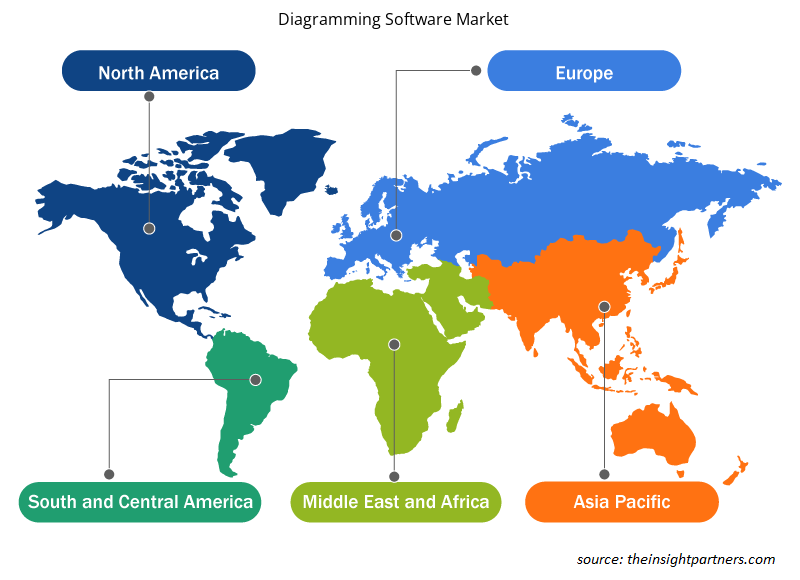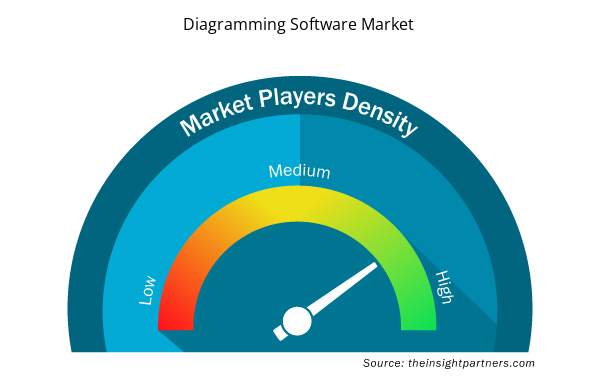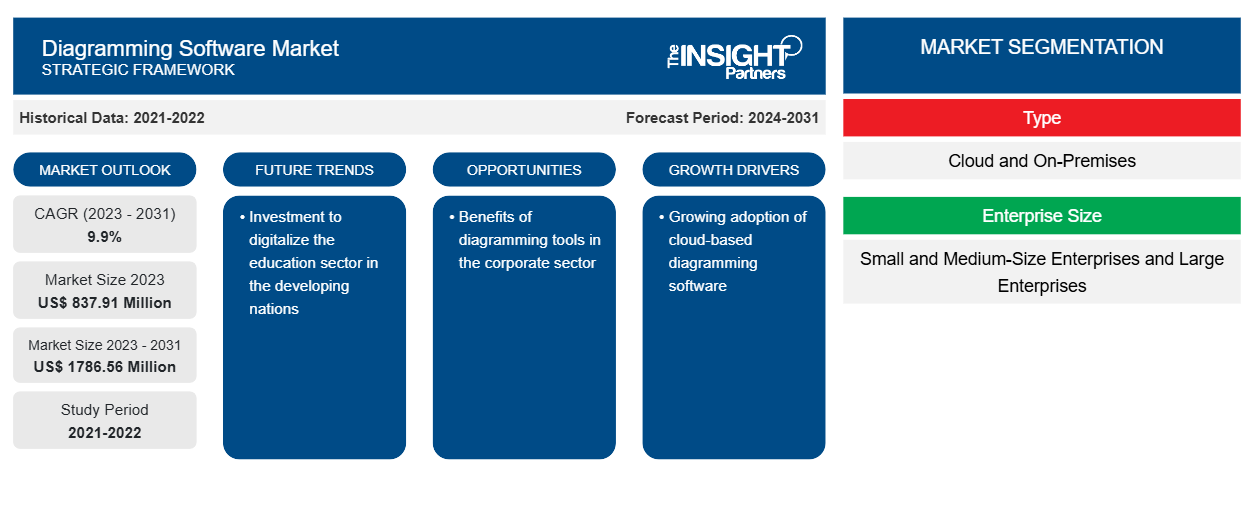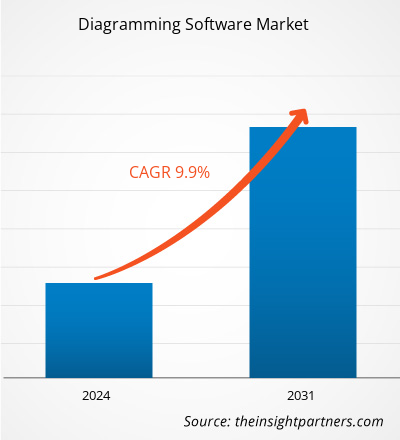Der Markt für Diagrammerstellungssoftware soll von 837,91 Millionen US-Dollar im Jahr 2023 auf 1786,56 Millionen US-Dollar im Jahr 2031 anwachsen. Der Markt wird zwischen 2023 und 2031 voraussichtlich eine durchschnittliche jährliche Wachstumsrate von 9,9 % verzeichnen. Die zunehmende Digitalisierung und die zunehmende Nutzung cloudbasierter Diagrammerstellungssoftware dürften weiterhin wichtige Trends auf dem Markt bleiben.
Marktanalyse für Diagrammerstellungssoftware
Der Markt für Diagrammerstellungssoftware gewinnt an Bedeutung, da sie zunehmend von großen und kleinen bis mittelgroßen Unternehmen genutzt wird. Die Einführung dieser Software hilft ihnen, den Arbeitsablauf und die Abläufe in der Geschäftsumgebung besser zu definieren . Verschiedene Abteilungen des Unternehmens wie Marketing, Personalwesen, Technik und Betrieb können sie umfassend nutzen.
Marktübersicht für Diagrammerstellungssoftware
Mithilfe von Diagrammerstellungssoftware kann der Benutzer detaillierte Diagramme erstellen, darunter Flussdiagramme, Kreisdiagramme, Grundrisse und andere Diagramme, basierend auf den Datensätzen und Bildern. Diagrammerstellungssoftware enthält verschiedene Vorlagen, die dem Benutzer helfen, das Diagramm von Grund auf neu zu erstellen. Diese Software lässt sich problemlos in andere Tools und Plattformen integrieren, sodass mehrere Benutzer das Diagramm anzeigen und zur Erstellung beitragen können.
Passen Sie diesen Bericht Ihren Anforderungen an
Sie erhalten kostenlose Anpassungen an jedem Bericht, einschließlich Teilen dieses Berichts oder einer Analyse auf Länderebene, eines Excel-Datenpakets sowie tolle Angebote und Rabatte für Start-ups und Universitäten.
- Holen Sie sich die wichtigsten Markttrends aus diesem Bericht.Dieses KOSTENLOSE Beispiel umfasst eine Datenanalyse von Markttrends bis hin zu Schätzungen und Prognosen.
Treiber und Chancen auf dem Markt für Diagrammerstellungssoftware
Vorteile von Diagrammtools im Unternehmenssektor
Diagramme helfen, die Komplexität der Kommunikation zu reduzieren. Im Geschäftsumfeld bieten Diagramme eine klare und prägnante visuelle Darstellung von Geschäftsprozessen. Sie helfen allen Mitarbeitern, die Ziele und Prozesse zu verstehen, die bei der Projektumsetzung befolgt werden müssen. Mit dem Einsatz von Diagrammtools können Teamleiter oder Projektmanager ihren Mitarbeitern den Projektablauf anhand eines Diagramms erläutern. Mithilfe von Diagrammsoftware können sie Kreisdiagramme, Flussdiagramme und verschiedene andere Diagrammvorlagen erstellen. Die visuelle Darstellung des Projekts oder der Geschäftsziele hilft den Mitarbeitern, die Trends und den Umfang des Projekts besser zu verstehen. Daher setzen Unternehmen häufig Diagrammsoftware ein.
Einführung cloudbasierter Software
Aufgrund der zunehmenden Industrialisierung und Globalisierungsinitiativen in Industrie- und Entwicklungsländern nehmen die Geschäftsaktivitäten in allen Branchen zu. Darüber hinaus wurde beobachtet, dass Unternehmen die digitale Transformation nutzen, um einen Wettbewerbsvorteil zu erzielen und ihre Produktivität zu maximieren. Dafür suchen die Unternehmen nach einer kostengünstigen Lösung, was zur Einführung der Cloud-basierten Diagrammerstellungssoftwarelösung führt.
Segmentierungsanalyse des Marktberichts zur Diagrammerstellungssoftware
Wichtige Segmente, die zur Ableitung der Marktanalyse für Diagrammerstellungssoftware beigetragen haben, sind Bereitstellungstyp, Unternehmensgröße und Anwendung.
- Basierend auf der Bereitstellungsart ist der Markt für Diagrammerstellungssoftware in Cloud und On-Premise unterteilt. Das On-Premise-Segment hatte im Jahr 2023 den größten Marktanteil.
- Nach Unternehmensgröße ist der Markt in kleine und mittlere Unternehmen sowie in große Unternehmen segmentiert. Das Segment der kleinen und mittleren Unternehmen wird voraussichtlich mit der höchsten durchschnittlichen jährlichen Wachstumsrate wachsen.CAGR.
- Nach Unternehmensgröße ist der Markt in Bildungseinrichtungen, Unternehmen und Personal segmentiert. Das Segment der Bildungseinrichtungen hielt im Jahr 2023 einen bedeutenden Marktanteil.corporates, and personnel. The educational institutions segment held a significant share of the market in 2023.
Diagrammerstellungssoftware Marktanteilsanalyse nach Geografie
Der geografische Umfang des Marktberichts für Diagrammerstellungssoftware ist hauptsächlich in fünf Regionen unterteilt: Nordamerika, Asien-Pazifik, Europa, Naher Osten und Afrika sowie Süd- und Mittelamerika.
Der asiatisch-pazifische Raum hatte den größten Marktanteil und wird voraussichtlich mit der höchsten durchschnittlichen jährlichen Wachstumsrate wachsen. Länder wie Indien, Japan und China halten den größten Marktanteil im asiatisch-pazifischen Raum. Die zunehmende Digitalisierung ist einer der Hauptfaktoren, die zur Einführung digitaler Lösungen führen. Wachsende E-Learning-Plattformen und wachsende KMU in Entwicklungsländern treiben die Einführung von Diagrammerstellungssoftwarelösungen voran.CAGR. Countries such as India, Japan, and China hold the majority of the Asia-Pacific market share. The growing digitalization is one of the major factors leading to the adoption of digital solutions. Growing e-learning platforms and growing SMEs in developing nations are driving the adoption of diagramming software solutions.
Regionale Einblicke in den Markt für Diagrammerstellungssoftware
Die regionalen Trends und Faktoren, die den Markt für Diagrammerstellungssoftware während des Prognosezeitraums beeinflussen, wurden von den Analysten von Insight Partners ausführlich erläutert. In diesem Abschnitt werden auch die Marktsegmente und die Geografie von Diagrammerstellungssoftware in Nordamerika, Europa, im asiatisch-pazifischen Raum, im Nahen Osten und Afrika sowie in Süd- und Mittelamerika erörtert.

- Erhalten Sie regionale Daten zum Markt für Diagrammerstellungssoftware
Umfang des Marktberichts zur Diagrammerstellungssoftware
| Berichtsattribut | Details |
|---|---|
| Marktgröße im Jahr 2023 | 837,91 Millionen US-Dollar |
| Marktgröße bis 2031 | 1786,56 Millionen US-Dollar |
| Globale CAGR (2023 - 2031) | 9,9 % |
| Historische Daten | 2021-2022 |
| Prognosezeitraum | 2024–2031 |
| Abgedeckte Segmente | Nach Typ
|
| Abgedeckte Regionen und Länder | Nordamerika
|
| Marktführer und wichtige Unternehmensprofile |
|
Dichte der Marktteilnehmer für Diagrammerstellungssoftware: Die Auswirkungen auf die Geschäftsdynamik verstehen
Der Markt für Diagrammerstellungssoftware wächst rasant, angetrieben durch die steigende Nachfrage der Endnutzer aufgrund von Faktoren wie sich entwickelnden Verbraucherpräferenzen, technologischen Fortschritten und einem größeren Bewusstsein für die Vorteile des Produkts. Mit steigender Nachfrage erweitern Unternehmen ihr Angebot, entwickeln Innovationen, um die Bedürfnisse der Verbraucher zu erfüllen, und nutzen neue Trends, was das Marktwachstum weiter ankurbelt.
Die Marktteilnehmerdichte bezieht sich auf die Verteilung von Firmen oder Unternehmen, die in einem bestimmten Markt oder einer bestimmten Branche tätig sind. Sie gibt an, wie viele Wettbewerber (Marktteilnehmer) in einem bestimmten Marktraum im Verhältnis zu seiner Größe oder seinem gesamten Marktwert präsent sind.
Die wichtigsten auf dem Markt für Diagrammerstellungssoftware tätigen Unternehmen sind:
- Kreativ
- zeichnen.io
- Gliffy von Perforce
- Edrawsoft
- Lucidchart
- Microsoft
Haftungsausschluss : Die oben aufgeführten Unternehmen sind nicht in einer bestimmten Reihenfolge aufgeführt.

- Überblick über die wichtigsten Akteure auf dem Markt für Diagrammerstellungssoftware
Neuigkeiten und aktuelle Entwicklungen zum Markt für Diagrammerstellungssoftware
Der Markt für Diagrammerstellungssoftware wird durch die Erfassung qualitativer und quantitativer Daten nach Primär- und Sekundärforschung bewertet, die wichtige Unternehmensveröffentlichungen, Verbandsdaten und Datenbanken umfasst. Nachfolgend sind einige der Entwicklungen auf dem Markt für Diagrammerstellungssoftware aufgeführt:
- Google hat das brandneue Google Cloud Architecture Diagramming Tool eingeführt. Mit diesem Tool kann der Benutzer die Vision mit dem Team teilen, mit ihnen zusammenarbeiten, das Design iterieren und die endgültige Version erstellen, die den Anforderungen für den Geschäftsanwendungsfall am besten entspricht. (Quelle: Google, Pressemitteilung, Februar 2022)
- EdrawMax, eine führende Diagrammerstellungssoftware, hat seine mobile Version, die EdrawMax App, herausgebracht, mit der Benutzer mühelos professionelle Flussdiagramme und Blockdiagramme erstellen können. Die neue App steigert die Produktivität und spart den Benutzern Zeit. Sie bietet über 20.000 hochwertige Diagrammvorlagen, die Benutzer anpassen und ändern können, um professionell aussehende Diagramme zu erstellen. (Quelle: PRNewswire, Pressemitteilung, April 2023)
Marktbericht zu Diagrammerstellungssoftware – Umfang und Ergebnisse
Der Bericht „Marktgröße und Prognose für Diagrammerstellungssoftware (2021–2031)“ bietet eine detaillierte Analyse des Marktes, die die folgenden Bereiche abdeckt:
- Diagrammerstellungssoftware-Marktgröße und -prognose auf globaler, regionaler und Länderebene für alle wichtigen Marktsegmente, die im Rahmen des Projekts abgedeckt sind
- Diagrammerstellung von Softwaremarkttrends sowie Marktdynamiken wie Treibern, Einschränkungen und wichtigen Chancen
- Detaillierte PEST/Porters Five Forces- und SWOT-Analyse
- Marktanalyse für Diagrammerstellungssoftware mit Blick auf wichtige Markttrends, globale und regionale Rahmenbedingungen, wichtige Akteure, Vorschriften und aktuelle Marktentwicklungen
- Branchenlandschaft und Wettbewerbsanalyse, die die Marktkonzentration, Heatmap-Analyse, prominente Akteure und aktuelle Entwicklungen für den Markt für Diagrammerstellungssoftware umfasst
- Detaillierte Firmenprofile
- Historische Analyse (2 Jahre), Basisjahr, Prognose (7 Jahre) mit CAGR
- PEST- und SWOT-Analyse
- Marktgröße Wert/Volumen – Global, Regional, Land
- Branche und Wettbewerbsumfeld
- Excel-Datensatz



Report Coverage
Revenue forecast, Company Analysis, Industry landscape, Growth factors, and Trends

Segment Covered
This text is related
to segments covered.

Regional Scope
North America, Europe, Asia Pacific, Middle East & Africa, South & Central America

Country Scope
This text is related
to country scope.
Häufig gestellte Fragen
The estimated value of the diagramming software market will be US$ 1786.56 million by 2031.
Creately, draw.io, Gliffy by Perforce, Edrawsoft, Lucidchart, Microsoft, FigJam, MyDraw, NULAB, and SmartDraw are some of the key players operating in the diagramming software market.
Investment to digitalize the education sector in developing nations is considered a key trend in the diagramming software market.
The rise in digitalization and growing adoption of cloud-based diagramming software are the key driving factors impacting the diagramming software market.
The global diagramming software market is estimated to register a CAGR of 9.9% during the forecast period 2023–2031.
Trends and growth analysis reports related to Technology, Media and Telecommunications : READ MORE..
The Insight Partners performs research in 4 major stages: Data Collection & Secondary Research, Primary Research, Data Analysis and Data Triangulation & Final Review.
- Data Collection and Secondary Research:
As a market research and consulting firm operating from a decade, we have published and advised several client across the globe. First step for any study will start with an assessment of currently available data and insights from existing reports. Further, historical and current market information is collected from Investor Presentations, Annual Reports, SEC Filings, etc., and other information related to company’s performance and market positioning are gathered from Paid Databases (Factiva, Hoovers, and Reuters) and various other publications available in public domain.
Several associations trade associates, technical forums, institutes, societies and organization are accessed to gain technical as well as market related insights through their publications such as research papers, blogs and press releases related to the studies are referred to get cues about the market. Further, white papers, journals, magazines, and other news articles published in last 3 years are scrutinized and analyzed to understand the current market trends.
- Primary Research:
The primarily interview analysis comprise of data obtained from industry participants interview and answers to survey questions gathered by in-house primary team.
For primary research, interviews are conducted with industry experts/CEOs/Marketing Managers/VPs/Subject Matter Experts from both demand and supply side to get a 360-degree view of the market. The primary team conducts several interviews based on the complexity of the markets to understand the various market trends and dynamics which makes research more credible and precise.
A typical research interview fulfils the following functions:
- Provides first-hand information on the market size, market trends, growth trends, competitive landscape, and outlook
- Validates and strengthens in-house secondary research findings
- Develops the analysis team’s expertise and market understanding
Primary research involves email interactions and telephone interviews for each market, category, segment, and sub-segment across geographies. The participants who typically take part in such a process include, but are not limited to:
- Industry participants: VPs, business development managers, market intelligence managers and national sales managers
- Outside experts: Valuation experts, research analysts and key opinion leaders specializing in the electronics and semiconductor industry.
Below is the breakup of our primary respondents by company, designation, and region:

Once we receive the confirmation from primary research sources or primary respondents, we finalize the base year market estimation and forecast the data as per the macroeconomic and microeconomic factors assessed during data collection.
- Data Analysis:
Once data is validated through both secondary as well as primary respondents, we finalize the market estimations by hypothesis formulation and factor analysis at regional and country level.
- Macro-Economic Factor Analysis:
We analyse macroeconomic indicators such the gross domestic product (GDP), increase in the demand for goods and services across industries, technological advancement, regional economic growth, governmental policies, the influence of COVID-19, PEST analysis, and other aspects. This analysis aids in setting benchmarks for various nations/regions and approximating market splits. Additionally, the general trend of the aforementioned components aid in determining the market's development possibilities.
- Country Level Data:
Various factors that are especially aligned to the country are taken into account to determine the market size for a certain area and country, including the presence of vendors, such as headquarters and offices, the country's GDP, demand patterns, and industry growth. To comprehend the market dynamics for the nation, a number of growth variables, inhibitors, application areas, and current market trends are researched. The aforementioned elements aid in determining the country's overall market's growth potential.
- Company Profile:
The “Table of Contents” is formulated by listing and analyzing more than 25 - 30 companies operating in the market ecosystem across geographies. However, we profile only 10 companies as a standard practice in our syndicate reports. These 10 companies comprise leading, emerging, and regional players. Nonetheless, our analysis is not restricted to the 10 listed companies, we also analyze other companies present in the market to develop a holistic view and understand the prevailing trends. The “Company Profiles” section in the report covers key facts, business description, products & services, financial information, SWOT analysis, and key developments. The financial information presented is extracted from the annual reports and official documents of the publicly listed companies. Upon collecting the information for the sections of respective companies, we verify them via various primary sources and then compile the data in respective company profiles. The company level information helps us in deriving the base number as well as in forecasting the market size.
- Developing Base Number:
Aggregation of sales statistics (2020-2022) and macro-economic factor, and other secondary and primary research insights are utilized to arrive at base number and related market shares for 2022. The data gaps are identified in this step and relevant market data is analyzed, collected from paid primary interviews or databases. On finalizing the base year market size, forecasts are developed on the basis of macro-economic, industry and market growth factors and company level analysis.
- Data Triangulation and Final Review:
The market findings and base year market size calculations are validated from supply as well as demand side. Demand side validations are based on macro-economic factor analysis and benchmarks for respective regions and countries. In case of supply side validations, revenues of major companies are estimated (in case not available) based on industry benchmark, approximate number of employees, product portfolio, and primary interviews revenues are gathered. Further revenue from target product/service segment is assessed to avoid overshooting of market statistics. In case of heavy deviations between supply and demand side values, all thes steps are repeated to achieve synchronization.
We follow an iterative model, wherein we share our research findings with Subject Matter Experts (SME’s) and Key Opinion Leaders (KOLs) until consensus view of the market is not formulated – this model negates any drastic deviation in the opinions of experts. Only validated and universally acceptable research findings are quoted in our reports.
We have important check points that we use to validate our research findings – which we call – data triangulation, where we validate the information, we generate from secondary sources with primary interviews and then we re-validate with our internal data bases and Subject matter experts. This comprehensive model enables us to deliver high quality, reliable data in shortest possible time.


 Holen Sie sich ein kostenloses Muster für diesen Bericht
Holen Sie sich ein kostenloses Muster für diesen Bericht